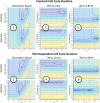Combined changes in Wnt signaling response and contact inhibition induce altered proliferation in radiation-treated intestinal crypts
- PMID: 27053661
- PMCID: PMC4884076
- DOI: 10.1091/mbc.E15-12-0854
Combined changes in Wnt signaling response and contact inhibition induce altered proliferation in radiation-treated intestinal crypts
Abstract
Curative intervention is possible if colorectal cancer is identified early, underscoring the need to detect the earliest stages of malignant transformation. A candidate biomarker is the expanded proliferative zone observed in crypts before adenoma formation, also found in irradiated crypts. However, the underlying driving mechanism for this is not known. Wnt signaling is a key regulator of proliferation, and elevated Wnt signaling is implicated in cancer. Nonetheless, how cells differentiate Wnt signals of varying strengths is not understood. We use computational modeling to compare alternative hypotheses about how Wnt signaling and contact inhibition affect proliferation. Direct comparison of simulations with published experimental data revealed that the model that best reproduces proliferation patterns in normal crypts stipulates that proliferative fate and cell cycle duration are set by the Wnt stimulus experienced at birth. The model also showed that the broadened proliferation zone induced by tumorigenic radiation can be attributed to cells responding to lower Wnt concentrations and dividing at smaller volumes. Application of the model to data from irradiated crypts after an extended recovery period permitted deductions about the extent of the initial insult. Application of computational modeling to experimental data revealed how mechanisms that control cell dynamics are altered at the earliest stages of carcinogenesis.
© 2016 Dunn, Osborne, et al. This article is distributed by The American Society for Cell Biology under license from the author(s). Two months after publication it is available to the public under an Attribution–Noncommercial–Share Alike 3.0 Unported Creative Commons License (http://creativecommons.org/licenses/by-nc-sa/3.0).
Figures






References
-
- Alberts B, Johnson A, Lewis J, Raff M, Roberts K, Walter P. Molecular Biology of the Cell, 4th ed. New York: Garland Science; 2002.
-
- Anastas JN, Moon RT. WNT signalling pathways as therapeutic targets in cancer. Nat Rev Cancer. 2012;13:11–26. - PubMed
-
- Appleton PL, Quyn AJ, Swift S, Näthke IS. Preparation of wholemount mouse intestine for high-resolution three-dimensional imaging using two-photon microscopy. J Microsc. 2009;234:196–204. - PubMed
-
- Bjerknes M, Cheng H. Clonal analysis of mouse intestinal epithelial progenitors. Gastroenterology. 1999;116:7–14. - PubMed
MeSH terms
Substances
Grants and funding
LinkOut - more resources
Full Text Sources
Other Literature Sources
Medical

